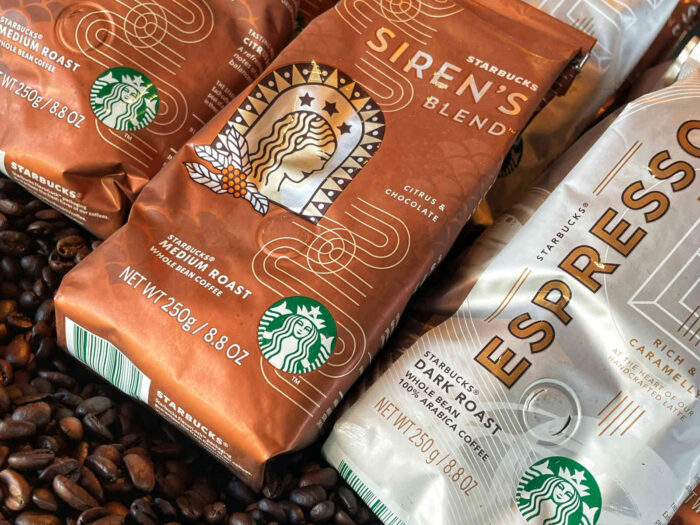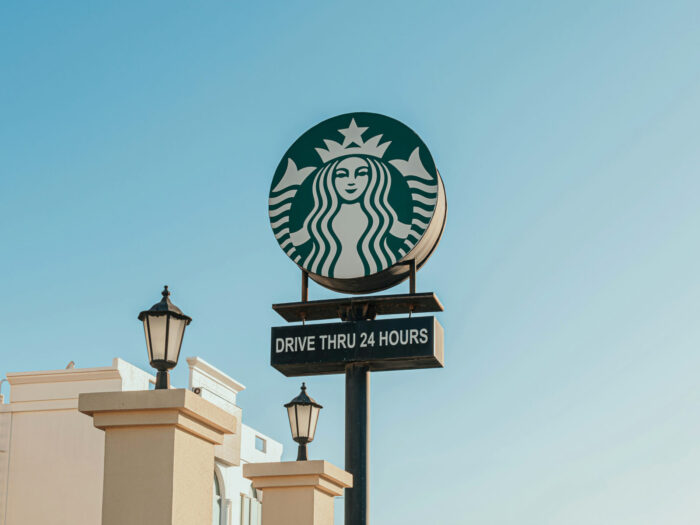
Starbucks’ marketing mix (4Ps) supports leadership in the global coffeehouse chain industry. This marketing mix identifies components of the coffee company’s marketing plan, namely, product, place, promotion, and price (the 4Ps).
In this business analysis case, Starbucks uses its 4P for its brand image and profitability. The company’s marketing mix and marketing strategy support brand development and multinational coffeehouse business growth.
Starbucks’ 4P responds to competitive forces involving other coffeehouse firms, like Tim Hortons, as well as foodservice companies, like Dunkin’, McDonald’s, Burger King, Wendy’s, and Subway.
These competitors challenge the company’s market position, as explained in the Five Forces analysis of Starbucks. The coffeehouse chain’s marketing mix functions as a strategic approach to counteract competition.
This marketing mix or 4P brings Starbucks’ products to food and beverage markets. With these 4Ps, the coffeehouse company’s marketing strategies and tactics promote products at the right places and prices. The success of this marketing mix boosts business effectiveness for Starbucks’ mission and vision.
Starbucks’ Products
This marketing mix component focuses on organizational outputs and what the coffee business offers as products for sale to its target customers. The following are the main product mix categories in Starbucks’ 4Ps:
- Drinks
- Food
- Starbucks Coffee at Home (instant and home-brew coffee)
- Merchandise (cups, tumblers, mugs, etc.)
Starbucks’ product mix is a result of years of business innovation and strategic changes in the marketing mix. For example, the company added the Frappuccino line after acquiring The Coffee Connection in 1994. Today, the business continues its product innovation to offer new foods and beverages that attract and keep more customers.
The resulting marketing mix, together with Starbucks’ generic strategy for competitive advantage and intensive strategies for growth, ensures that products match consumer preferences in a diverse international market.
Thus, this part of Starbucks’ 4Ps involves beverages, foods, and merchandise that are carefully selected or designed to meet market demand and satisfy the needs and preferences of target buyers and consumers worldwide.

Price in Starbucks’ 4Ps
Starbucks uses a premium pricing strategy. This strategy involves relatively high price points and price ranges for products that the coffeehouse business presents as superior-quality or high-end (“premium prices” for “premium products”).
In the marketing mix context, Starbucks’ pricing strategy takes advantage of the behavioral tendency of consumers to purchase expensive products based on the perception that high prices mean high quality, high value, and high status.
By emphasizing premium quality and high value through premium pricing, this part of the 4P also helps strengthen Starbucks’ premium brand against competitors, like McDonald’s McCafé Premium Roast.
Starbucks’ operations management optimizes product quality, production costs, and related variables to maximize profit margins while supporting the premium pricing strategy used in this marketing mix.
Place in Starbucks’ Marketing Mix
This marketing mix component determines the venues or places where customers access the company’s foods, beverages, and merchandise. Starbucks offers most of its products at cafés or coffeehouses. However, other places or channels of distribution are included in this 4P. Starbucks’ marketing mix uses the following venues or places to reach target customers:
- Coffeehouses/Cafés and kiosks
- Retailers
- Website and mobile apps
Coffeehouses/cafés and kiosks are the most noticeable places in Starbucks’ marketing mix. These places are strategically located in areas that have high pedestrian or vehicular traffic, such as malls and commercial centers.
Starbucks’ organizational structure (company structure) facilitates the management of franchising and licensing operations for these store locations. The company’s structure ensures sufficient corporate support for coffeehouse operations.
Retailers are also included in Starbucks’ 4Ps, as channels for maximizing distribution and market reach. These places enable the company to widely distribute and sell coffee products, such as VIA instant coffee and other merchandise.
In addition, online venues are in Starbucks’ marketing mix. The company’s website and mobile apps provide easy access for customers who want to check available products or place their orders for pickup or for delivery through third-party service providers.
The information technology used in this 4P component addresses the sociocultural and technological trends described in the PESTEL/PESTLE analysis of Starbucks, such as the widespread use of mobile devices for online purchases.
Starbucks’ marketing mix involves strategies and tactics that use different types of locations to optimally distribute and sell food and beverage products. The high visibility and accessibility of these places contribute to a positive brand image, which is one of the competitive advantages and business strengths assessed in the SWOT analysis of Starbucks.

Starbucks’ Promotion
In this marketing mix, promotion involves communication strategies and tactics for the goal of improving Starbucks’ brand, revenues, and market share. For example, the promotional mix can focus on persuading consumers to buy the company’s tea and instant coffee products. Starbucks’ marketing mix includes the following promotion activities:
- Word-of-mouth marketing
- Advertising
- Sales promotions
- Public relations
Word-of-mouth marketing is the most significant promotional strategy in Starbucks’ marketing mix. The company focuses on high-quality customer experience to encourage people to spread positive reviews that promote the coffeehouse business. Starting with Howard Schultz’s leadership, the emphasis on high quality through Starbucks’ company culture (work culture) promotes such good experiences for customers.
In addition, advertising is an integral part of Starbucks’ 4Ps. For example, the company’s coffee ads reach target customers through the Internet and print media. Advertisements promote the brand and encourage customers to consume more Starbucks products.
Moreover, this marketing mix involves sales promotions as a communications strategy to persuade consumers to buy more of the company’s foods and beverages. For example, the Starbucks Rewards program provides freebies for customers. In this approach, consumers buy more of the company’s products while expecting freebies, such as free coffee.
Furthermore, the company uses public relations to promote its brand, coffee, and other products. In the 4P context, the Starbucks Foundation functions as a part of a public relations strategy. The Foundation assists organizations and communities, and promotes the coffeehouse company at the same time.
Considering the significance of the Starbucks Foundation in public relations, Starbucks’ stakeholder management and corporate social responsibility (CSR) and ESG strategy for sustainability and other goals also relate to this marketing mix.
References
- Cai, S., Liu, Y., Aduldecha, S., & Junaidi, J. (2025). Leveraging customer green behavior toward green marketing mix and electronic word-of-mouth. Sustainability, 17(6), 2360.
- Morgan, N. A., Menon, A., Jaworski, B. J., & Musarra, G. (2025). Marketing strategy implementation: Why is it so hard? Journal of Business Research, 190, 115231.
- Starbucks Coffee Company – Menu.
- Starbucks Corporation Form 10-K.
- Starbucks Delivers.
- Starbucks Rewards.
- The Starbucks Foundation.
- U.S. Department of Agriculture – Economic Research Service – Food Service Industry Market Segments.
- Ziliani, C. (2025). Loyalty strategies and the test of time: Barilla and Starbucks. In Loyalty Management (pp. 232-257). Routledge.